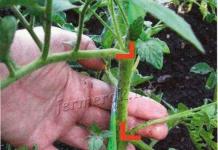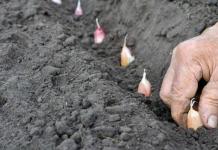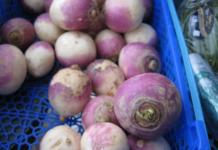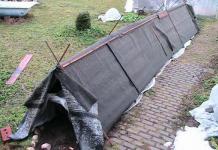Thanks to the latest technology and a detailed study of biology, growing watermelons in a greenhouse has become possible even in the most severe climatic conditions. Consider some tips and tricks that will help you understand in detail the technology for growing these crops.
Optimal working conditions
The first thing you should pay attention to is that watermelon and melon (see Growing melon in a greenhouse - let's experiment) are heat-loving berries. Seeds begin to germinate at a temperature of at least 18 degrees, and the best option is from 25 to 35 degrees.
Note. For favorable growth, daytime temperatures should be maintained at 25-30 degrees during the day and 18 degrees at night.
Additional things to consider:
- Melon and watermelon are drought tolerant, and react negatively to high humidity.
- Therefore, the optimum air humidity should vary from 60 to 70%.
- Cucurbitaceae make rather high demands on the temperature regime and air humidity during rooting. For the middle band, these factors play a big role.
The secret to success in the right varieties is also influenced by the watermelon greenhouses themselves. For these purposes, the Strelka or Volya greenhouse is perfect.
What varieties are used for the middle band

Before you grow a watermelon in a greenhouse, you need to pay due attention to the selection of the right varieties.
Advice. For central Russia, early ripe varieties are suitable. It is also not recommended to chase varieties with large fruits, they are not suitable for this strip and will be able to realize themselves only in appropriate conditions in the south.
What you need to know, as additional information:
- When buying fruits for cultivation, it is necessary to take into account in the description the number of days from setting to ripening.
- It is best to give preference to varieties that are able to develop in the middle lane.
- You can ignore the shape of the fruit (if you are growing for yourself).
Varieties for the middle band:
- Pink champagne.
- Moscow Region Charleston.
- Gift to the north.
- Crimstar.
One of the best melon varieties is 'Cinderella', which has a sweet fruit and is easy to grow.
Greenhouse for watermelons and melons: growing seedlings
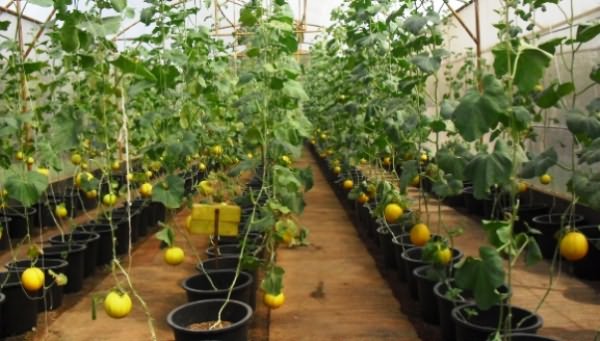
In the middle lane, watermelons and melons are grown only through seedlings, and the future harvest depends on the quality of the seedlings.
Let's take a closer look:
- The duration of cultivation, as for all pumpkins, is about a month.
Advice. Seedlings are grown strictly in pots to prevent damage to the root system.
- For seedlings, pots with a diameter of 100 mm are used, in such pots 2 crops can be placed at once.
- Before growing watermelons in a greenhouse (before sowing), the seeds are soaked, or germinated.
- To get good shoots, you need a temperature regime of 27 to 30 degrees.
- For seedlings from 20 to 25 degrees and 18-20 degrees at night.
- Seeds for seedlings are planted in mid-April in the sunniest place.
- Seedlings will be better if grown in a warmed and glazed loggia.
- During the process, it is necessary to make 2 fertilizing with minerals. All work can be done by hand, without the involvement of specialists.
Advice. Pay attention to the arrangement of crops, it is very important that they do not come into contact with the leaves, so the pots must be moved apart.
- Seedlings in finished form should have from 3 to 5 leaves.
- A week before transplanting, seedlings are specially hardened. During the day, the temperature is artificially reduced to 17 degrees, and at night to 16 degrees.
There are differences between melon and watermelon when growing seedlings. Watermelons form female petals, both on the side and on the main stem.
And on a melon, female petals are formed on the lateral stems earlier than on the main stem. Therefore, during the seedling period, pinching is performed at the melon over the 5th leaf.
Conditions for growing crops
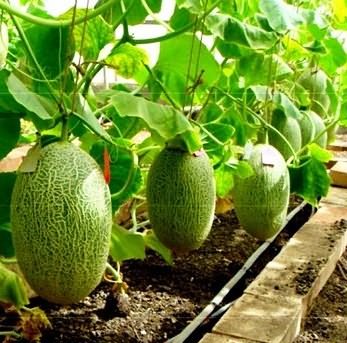
Melon in the middle lane is grown strictly in a greenhouse or under temporary film cover.
Greenhouse for watermelons and its features:
- The design can be of any shape and area. But its height should be at least 200 cm. In order to grow crops with high quality, you will need trellises, to which plants are tied. Greenhouses for watermelon are designed for solar heating.
Advice. Many vegetable growers do not deal only with watermelons and melons, but additionally grow tomatoes, cucumbers, eggplants and other crops. In our case, it is better to plant crops along with tomatoes, where there is lower humidity.
- A watermelon greenhouse is prepared according to a special standard scheme. In early April, the snow is cleared and covered with a film coating.
- When the soil thaws, cold hardy early ripening crops are sown.
- After the harvest, there are already heat-loving crops, including melons and watermelons.
- When green crops are grown, the soil warms up qualitatively. Watermelons and melons should only grow to the trellis.
Advice. If you plan to grow watermelons along with tomatoes, peppers and eggplants, then it is better to plant them in the north side.
Seedling planting instructions
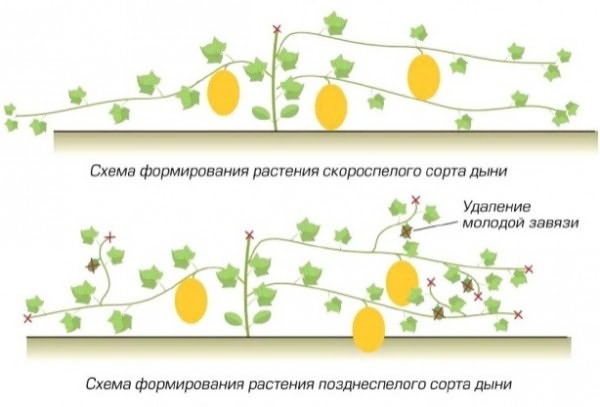
Given that watermelons and melons prefer warmth, it is best to get down to business in early May.
So:
- At this time, the daytime temperature maneuvers from 15 to 20 degrees, and at night 5-10. Under the film coating, the temperature rises to 30 degrees.
- The bottom line is that inexperienced vegetable growers immediately begin to plant heat-loving crops under a film cover.
- Sometimes it happens that by mid-May the weather deteriorates, sometimes even frosts come. If the tomato can withstand a long cold snap, then heat-loving crops will die instantly.
After carrying out all the work, the plants are covered with a film.
How to care for crops
Initially (in the first week) no care will be required, except for the fact that it will just need to be aired in good warm weather.
Advice. Airing is best done at temperatures above 30 degrees.
After a week, when the soil dries up, you can water the plants with warm water (mixed with 20 g of saltpeter into a solution of water (10 l). Only 2 liters of solution goes to the hole. Care in the greenhouse and under the greenhouse film have a difference, let's take a closer look.
Seedling care in the greenhouse
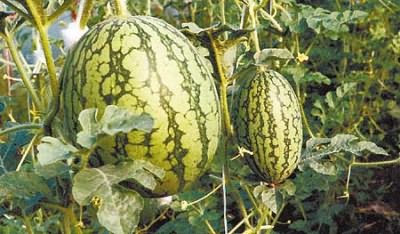
After about 1.5 weeks, the plants are tied up. The technique resembles working with cucumbers.
Watermelons are grown in one stem, and with side shoots they do this:
- Shoots without ovaries are removed.
- Shoots that have started are pinched. 3 leaves are left above the ovary.
- When the plant reaches the trellis, it is pinched.
- When 2-3 fruits reach the size of a chicken egg, the rest of the ovaries are removed.
As for the melon, everything happens as follows:
- During the seedling period, the plant produces several side shoots. Of these, no more than 2 of the strongest are selected.
- Then they are led as the main ones and tied to the trellis, and the rest of the shoots are removed.
- Then, everything is formed in the same way as with watermelons.
- In addition to the formation, once a week it is necessary to water. When the fruits ripen, the amount of watering is reduced.
- Then it is necessary to organize 2 more top dressings with complex substances with a difference of 2 weeks.
- Also take care of timely pollination of fruits.
Advice. If it is found that some fruits grow intensively, while others do not want to develop, then this indicates insufficient nutrition of the crops.
Harvesting

The last, no less important stage of growing crops is harvesting. Despite the fact that some fruits may seem large, in no case should you rush to collect them, some pumpkins may not yet ripen.
Determining maturity can be very simple:
- For example, a melon takes on a characteristic color, and directly emits the aroma of a ripe fruit.
- With watermelon, things are a little more complicated. An inexperienced person may not be able to tell.
A ripe watermelon acquires a clear pattern, the wax coating weakens, and when tapped, a muffled sound. For more detailed information, it is recommended to watch a video where you can get acquainted with the technique for growing and caring for fruits.
parnik-teplitsa.ru
How to grow watermelons and melons in cold regions of Russia
In the old days, my mother always planted two melon seeds in the greenhouse. varieties Collective farmer. By the end of summer, about five yellow fragrant melons the size of a dessert plate appeared on our table. They were not as sweet as imported southern ones, but they were completely environmentally friendly.
Later, when many varieties of melons and watermelons appeared in stores, indicating "ultra-early", "early", "northern", a lot of money was spent on these treasures.
Alas, at best, analogues of our melon Collective Farm Girl grew, and the watermelon Sugar Baby, or in the English manner Suga baby, generally turned out to be a domestic Spark.
Numerous experiments with seeds resulted in the selection of one variety of medium-sized early sweet melon and one variety of watermelon, also small.
Large ones, although they gave a good harvest, but the pulp clearly lacked sugar content.
It is noteworthy that neither one nor the other variety completely corresponded to the descriptions that were given on the packages. So your favorite watermelons and melons grow nameless.
How I grow my melons and watermelons
- I collect seeds only from the first ripened fruits and dry them.
- Before sowing, be sure to pickle in a pink solution of potassium permanganate.
- Then I wrap the seeds in a linen napkin and water with a solution of aloe juice (5 drops per 1 tablespoon of water) so as to only moisten the cloth. I keep it in a warm place, regularly sprinkling with a solution of aloe juice until the seeds hatch. It is advisable to do this on April 18-25.
- I plant each hatched seed in a 9x9x9 cm plastic container with fertile loose soil, water it, cover it with a film and put it on a south, well-lit window
- With the appearance of a sprout, I remove the film and make sure that the plant does not stretch, in warm weather I put it on a glazed loggia.
After May 9, I plant seedlings on a warm bed, cover with plastic bells from five-liter water bottles, then cover with two layers of plastic wrap in arcs.
In recent years, our summer has become noticeably warmer, so we already grow melons with watermelons not in a greenhouse, but in a small film tunnel along with peppers. Yes, and they grow under the film only in May-early June.
Then we remove the film and return it to the arcs again only in the second half of August.
So that gourds do not interfere with the growth of peppers, we plant two copies of melon and watermelon at the end walls. In the tunnel, every 3 m I put a ten-liter bucket of water: during the day the water heats up and gives off heat at night. At the same time, the humidity in the tunnel also increases.
Growing watermelons and melons- the process is fascinating, children are well attached to it: even kids are happy to pull out weeds on our “melons”, water watermelons.
Therefore, every year I buy new seeds for testing, because I want to finally get a fruitful and excellent variety or hybrid in taste.
I plant the novelty in a greenhouse, where I tie up the shoots, and place the pouring fruits in nets.
If earlier it was impossible to drag the children into the greenhouse, then with the appearance of the first ovaries on a watermelon or melon, they check the “weight gain” every morning and already know when the plants need to be watered or sprayed on the leaf, open or close the windows in the greenhouse.
I regularly water watermelons and melons once every 2 weeks with an infusion of manure or nettle, once a month with an infusion of wood ash. I stop watering 2 weeks after fruit set.
It is very important to pinch the shoots in a timely manner and remove the ovaries - I usually leave 3-4 ovaries. I form watermelons in 3 lashes, and pinch all side shoots of melons after the first flower appears on them (more on pinching plants, including melons and watermelons).
vsaduidoma.com
Melons and watermelons: growing seedlings | Kitchen garden | Garden Star - information portal
Useful qualities of watermelon and melon
Watermelon- a berry that is rich in fiber, it is known that it perfectly improves bowel function and assists our stomach in digesting food. This berry is useful for diseases of the cardiovascular system, kidneys, because it is an excellent diuretic: it removes unnecessary fluid from the body, harmful toxins and cholesterol. And also watermelons significantly improve the general condition of the body with atony and hypertension of the intestine.
Melon- it contains starch, easily digestible sugar, vitamins, proteins, fiber, organic acids, pectins, various mineral salts, as well as potassium and iron salts. This fruit is useful for people who suffer from cardiovascular diseases, anemia, gout, rheumatism, kidney disease. And lovers of a beautiful tan should definitely eat melon pulp, as it contributes to a stable and even tan.
Since melon contains folic acid, it is very useful for expectant mothers and women in menopause. Vitamins C, E, B2, B6, pantothenic and nicotinic acid supply the body with antioxidants - so melon helps to prolong youth.
How to plant watermelon and melon seedlings
Melons and watermelons are heat-loving plants, therefore they grow mainly in the southern regions. But, if you use the seedling method of growing and protect it from spring frosts, you will get a good harvest of early and late large-fruited varieties.
The most optimal for these fruits are light chernozems and sandy loamy soils.
Fertilized soil significantly increases the likelihood of a good harvest, but you need to bring in not fresh manure, but humus, calculating as follows: 3 centners per 100 square meters. m. For watermelons, mineral fertilizers (potassium and phosphorus) are suitable, and humus is quite enough for melons.
When planting watermelons and melons it is better to use the nesting method, that is, place the holes, depending on the variety, at the following distances: watermelons - from one and a half to two meters, melons - from one to one and a half meters. Short climbing early varieties are best planted thicker, but late and medium, long climbing varieties are a little less common. In the process of planting, 0.5 - 0.8 kg is introduced into the hole. humus, and for watermelons, about 15 gr. superphosphate and 4 - 5 grams of potash fertilizer.
For sowing, it is better to use 2 - 3-year-old seeds. It is also allowed to sow fresh seeds, but in this case they need to be dried a little before sowing (2-3 days), the temperature should be 30-35 degrees. Plants that are grown from two - three-year-old or heated seeds will bloom much earlier, as a result of which the fruit ripening process is significantly accelerated, and the yield is larger.
For watermelons, the seeding depth should be 5 - 6 centimeters, for melons - 3 - 4 centimeters.
Watermelons and melons germinate after sowing within 8-10 days. If some seeds do not germinate, then you can re-sow.
- To get an early harvest of melons and watermelons, it is better to use potted seedlings. Plant 2-3 seedlings with pots in each hole and water abundantly before planting, then sprinkle the holes with dry earth.
- It is necessary to start caring for crops immediately after shoots have appeared from loosening row spacings; such loosening must be repeated throughout the summer about 4-5 times.
- Also, young plants can be protected from frost by fumigation. On the site, it is necessary to decompose heaps of dry manure in advance, then it is better to light it before dawn (at low temperatures), forming a smoke screen.
gardenstar.ru
Business for growing watermelons and melons in a greenhouse
To be able to grow a non-traditional crop for a certain climatic zone is considered a skill in vegetable growing and horticulture. Today, it is not often possible to find apricot, grapes and cherries in garden plots. With representatives of gourds, the situation is simpler, but they are also not frequent guests on personal plots.
Thanks to a detailed study of heat-loving crops, the development of unique technologies for their cultivation, today almost any summer resident can grow watermelons and melons in a greenhouse, even in the Moscow region.
Melon and watermelon are warm and light-loving gourds. When planting a melon in a greenhouse, its seeds germinate at a temperature of 18ºС, but the best temperature for it will be from 27 to 35ºС. In order for melons and watermelons to feel good in a greenhouse, daytime temperatures should be within 30ºС, and night temperatures should not fall below 18ºС. Both melon and watermelon are resistant to drought, but are afraid of high humidity. If the humidity is very high, then they are prone to the development of a variety of fungal diseases.
Air humidity of about 60% will be optimal for growing watermelons in a greenhouse. The secret to the successful cultivation of such crops will be the correct choice of a suitable variety and the provision of the necessary agricultural technology.
The selection of varieties for central Russia is very wide today. And there is no need to chase varieties with giant fruits, they can realize such properties only in southern conditions. When reading the description of a particular variety, it is necessary to pay attention to the period from fruit set to ripening (the smaller it is, the better it will be). The melon in the greenhouse should be of such a variety that it would have a short ripening period.
How are melons and watermelons grown?
"How to grow a melon in a greenhouse or how to grow watermelons in a greenhouse?" - you ask. In our area, melon and watermelon can be
grow only using seedlings, the quality of which will largely depend on the future harvest.
As for all types of pumpkin crops, the period of growing seedlings of melon and watermelon is not significant and lasts about a month. Seedlings should be grown in pots to avoid damage to the root system. Pots are used with a diameter of about 10 cm, the seeds are soaked before planting, this reduces the period of similarity of the culture. To obtain good seedlings, the temperature at which it will grow must be within 25ºС.
Throughout the entire period of growing seedlings, two plant feedings are carried out using complex mineral fertilizers. You also need to make sure that the plants do not touch each other, for this the pots are periodically moved away from one another, as the plants increase in volume. In the central zone of our country, melon and watermelon can be successfully cultivated only in a greenhouse, a greenhouse for these crops will be small.
If you plan to grow melons in a greenhouse, then the greenhouse should be at least 1.7 m high, it is better if it is 2 m. Usually solar-heated greenhouses are used for such purposes.
Of course, the melon in the greenhouse will not be the only representative, next to it you can successfully grow watermelons, tomatoes, bell peppers, eggplants, cucumbers and other crops. In this case, the seedlings of melon and watermelon are planted in a greenhouse with the main crops planned for cultivation.
Some summer residents use two greenhouses, one of which is used for growing melons and watermelons, and the other for all other crops. This approach to solving the issue of growing is the most correct, because for each of the crops you can choose the required temperature, relative humidity and daylight hours.
Preparing the greenhouse for cultivation
The greenhouse is prepared as usual in late March or early April, the snow is removed and the frame is covered with foil. After the soil thaws, early ripening cold-resistant crops are sown. After harvesting, it is the turn of seedlings of heat-loving crops to come, melon and watermelon are no exception. During the cultivation of greenery, the soil in the greenhouse is already quite well warmed up. It must always be remembered that in a greenhouse, melon and watermelon grow up to about 2 m in height, up to a trellis. Therefore, if watermelons and melons are planned to be grown with other crops, such as, say, bell pepper, then it is better to land on the north side of the greenhouse so as not to obscure other crops.
How to grow a melon in a greenhouse and get a good harvest? This will primarily depend on the seedlings. Since melon and watermelon are heat-loving crops, it is unnecessary to rush to plant seedlings. In some years, in our country, or rather its middle zone, quite warm weather sets in by the beginning of May, the daytime air temperature reaches 20ºС, and at night it does not fall below 5ºС. In the greenhouse, in the daytime, the temperature can rise to 30ºС and above . And at this time, inexperienced summer residents begin planting heat-loving crops under the film, but often by the middle of May the weather conditions worsen, and there may even be frosts. If we talk about crops such as tomatoes, they can withstand sharp drops in temperature, but watermelon and melon can die. Therefore, based on many years of experience, it is recommended to plant watermelon and melon seedlings in a greenhouse after the twentieth of May. Before landing, it will not be superfluous to find out the long-term forecast from weather forecasters.
If, nevertheless, after some period after planting, the temperature drops, then we need to protect our seedlings using old film, paper, rags, etc. Also, in a film greenhouse for a period of cooling, a simple frame is additionally installed above the seedlings, which is covered with any materials at hand.
Plant care after planting
Usually in the first week after planting, no care is needed for the plants, except for airing the greenhouse on sunny, clear days. Ventilation is done when the temperature in the greenhouse exceeds 30ºС, for this you just need to open the windows, or tuck the film on its ends.
After two weeks, they begin to water the crops with warm water, combining watering with ammonium nitrate and nitrogen fertilizers. Watering is done very carefully, trying so that water does not fall on the hypocotyl knee and plant leaves. Approximately ten days after planting, work is done on the garter of plants. The garter system is the same as for cucumber cultivation.
Watermelon is grown in one stem, with lateral shoots formed in the axils of the leaves themselves. This is done as follows: shoots on which there is no ovary are removed; pinch the shoots with the ovary, leaving only a couple of leaves above the fruits. After the plant reaches the height of the trellis, it is re-pinched.
The melon is tied up as follows: after the top of the plant has been cut off from it, during the seedling period, lateral shoots are formed. It is necessary to choose a couple of the strongest of them, and delete the rest. Further, everything is the same as with the garter of a watermelon.
It must always be remembered that one of the most basic stages in the cultivation of watermelon and melon is the garter of the fruits themselves. Usually fruits that have reached the size of an apple are placed in the middle of the net, which in turn is tied to the edge of the trellis, this is done with each of the fruits. And the last, and perhaps the most pleasant stage in the cultivation of these crops will be their harvesting, but there is also no need for haste here - even an impressive size watermelon or melon fruit can be unripe. You can determine maturity in different ways, melon - by its characteristic color, and watermelon by a certain sound. Good luck and happy growing!
| Login form |
intersbook.do.am
Tagged





